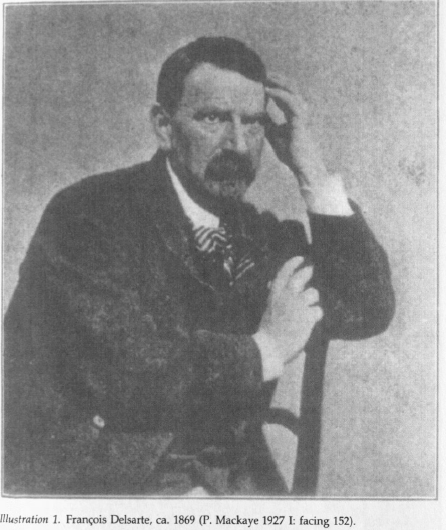François Delsarte was born on November 19, 1811 in the small town of Solesmes, France.[1] His father, an inventor, wasted his money leaving the Delsarte family bankrupt.[2] Delsarte’s mother, who originally came from a wealthier family, left her husband to find work in Paris.[3] She left you two youngest children with their grandmother and brought along her two eldest, François and his brother Louis.[4] Soon, both she and Louis died, leaving Delsarte alone in the city.[5] A music professor named Bambini recognized Delsarte’s talent and took the young boy into his home and soon encouraged him to attend the Paris Conservatory for more formal vocal and performance training.[6] And so Delsarte would be a student there from 1826 to 1829.[7] Delsarte expressed much dissatisfaction with his instruction there, criticizing the inconsistency and poor methods among his teachers.[8] He felt that they contributed to the artificial acting style of the time and claimed that they also ruined his voice.[9] Scholar Nancy Ruyter writes, “Delsarte saw no general principles of aesthetics, expression, or method underlying the training, and also no concern with the qualities of naturalness and believability that he considered important.”[10]

Photograph of Delsarte (1869)
After leaving the conservatory, Delsarte found it hard to get work, and did not perform often.[11] This gave him time to further develop his own theories of expression. He endlessly study the human body, even completing a year of medical school.[12] In 1833 he published his first treatise on singing.[13] It was in that same year that he also married pianist from Conservatory, the young Rosine Charlotte Andrien.[14] Whatever impairment his voice may have incurred at the conservatory, Delsarte performed consistently from 1839 to 1866 in his own concerts and often with his students, strategically picking songs that fit his vocal ability and relying on his acting technique.[15] He took on many students at this time including famous opera and stage stars, instructing them in his unique style and theory of performance.[16] Many of his contemporary critics gave Delsarte and his students high praise for their ability to skillfully and successfully combine acting with their vocal talents.[17] Delsarte gave private lessons to his pupils and in 1839 he gave the first of what would be many lectures known as the “Course of Applied Aesthetics.”[18]
By the time he went into semi-retirement in the 1860s due to his declining health, he had seven children with his wife, all of whom learned some of his work.[19] Some even went on to teach his method and carry on his legacy.[20] Delsarte died in 1871, highly respected for his talent and ideas. He meant the Delsarte System to be for many artistic disciplines including painting, composing, and literature.[21] His work continues to live on through many performance disciplines today.
[1] Ruyter, Nancy Lee Chalfa. The Cultivation of Body and Mind in Nineteenth-Century American Delsartism. Greedwood Press, 1999, 3-4.
[2] Supra. n. 1
[3] Supra. n. 1
[4] Supra. n. 1
[5] Supra. n. 1
[6] Supra. n. 1
[7] Supra. n. 1
[8] Supra. n. 1
[9] Supra. n. 1
[10] Supra. n. 1
[11] Supra. n. 1 at p. 5
[12] Shawn, Ted. Every Little Movement: A Book About François Delsarte. Dance Horizons, 1954, 16.
[13] Supra. n. 1 at p. 5
[14] Supra. n. 1 at p. 5
[15] Supra. n. 1 at p. 5
[16] Supra. n. 12
[17] Supra. n. 1 at p. 6
[18] Supra. n. 1 at p. 6
[19] Supra. n. 1 at p. 7
[20] Supra. n. 1 at p. 7
[21] Supra. n. 1 at p. 7
